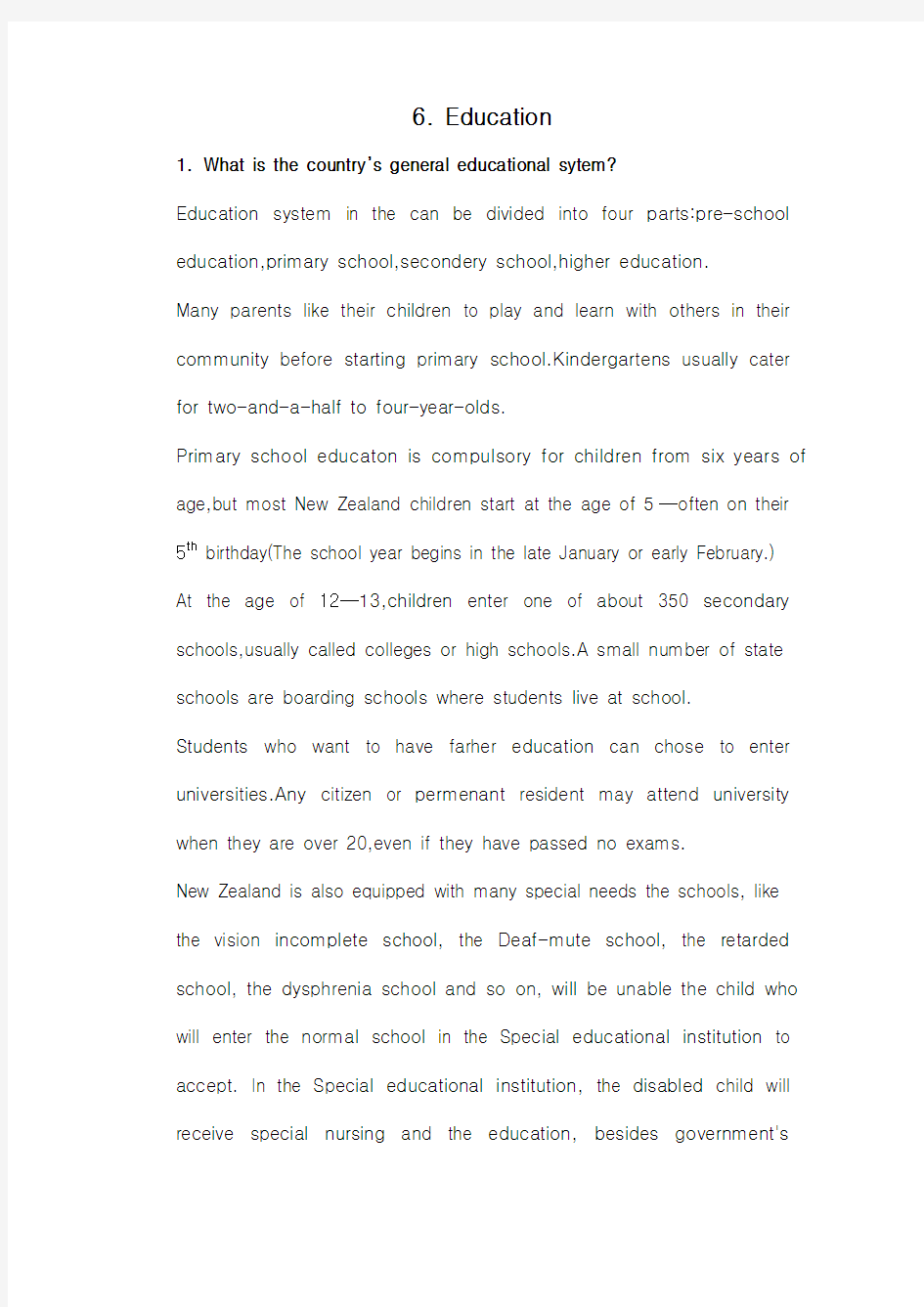education of New Zealand


6. Education
1.What is the country’s general educational sytem?
Education system in the can be divided into four parts:pre-school education,primary school,secondery school,higher education.
Many parents like their children to play and learn with others in their community before starting primary school.Kindergartens usually cater for two-and-a-half to four-year-olds.
Primary school educaton is compulsory for children from six years of age,but most New Zealand children start at the age of 5—often on their 5th birthday(The school year begins in the late January or early February.) At the age of 12—13,children enter one of about 350 secondary schools,usually called colleges or high schools.A small number of state schools are boarding schools where students live at school.
Students who want to have farher education can chose to enter universities.Any citizen or permenant resident may attend university when they are over 20,even if they have passed no exams.
New Zealand is also equipped with many special needs the schools, like the vision incomplete school, the Deaf-mute school, the retarded school, the dysphrenia school and so on, will be unable the child who will enter the normal school in the Special educational institution to accept. In the Special educational institution, the disabled child will receive special nursing and the education, besides government's
welfare, some hospitals and the social charitable department will subsidize these schools regularly. Completed the studies for the help current economic condition bad student, the government has drawn up the student lending policy.
2.w ho is responsible for education finance and policy (central
government or local government or ?)?
Most of the schools in New Zealand are state schools. New Zealand Overwhelming majority Middle school is the State school, the individual Private gymnasium retention has the respective philosophy or the religious tradition.It has 24 state Technical institutes,8 state universities.So the education is most responsed to the central government.
3.What courses are taught in the public elementary and secondary
school?
Primary school: the child will study English (including writing, spoken language, written language, to read aloud and spelling) disciplines and so on art, health, mathematics, music, physics, natural sciences and social sciences.
Secondary school: The accounting, the household economics, the spinning and weaving, the clothing and the design, the history, the biology, the agronomy and raising livestock study, art, the human body
biology, chemistry, the typing and the information management science, the comercial science, Japanese, the computer study, mathematics, the classical study, the legal study, the economic, music, the play, passes on Neo-Confucianism, French, the sports, English, the photography, German, the science, the geography, the physics, health education, Spanish, image and design, sociology, gross profit study, design technique
4.Introduce 1 or 2 famous universities.
Lincoln University is one of eight government universities in New Zealand, with a history stretching back more than a hundred and twenty five years.
The University is less than twenty five minutes from Christchurch, the largest city in the South Island. It has an established campus noted for its space and the quality of the environment.
The 58 hectare campus houses modern teaching spaces, an excellent library and campus facilities, and accommodation for approximately 650 students during the university year.
World Renowned
The University continues to achieve international recognition for its teaching and research activities.
It is renowned for its entrepreneurship, relevance and as a catalyst for new and diverse approaches to stimulate the development and transfer of knowledge.
The University fosters alliances with the users of research information both nationally and internationally and has established a number of significant alliances with other research organisations.
Moving Forward
The University has undergone a number of changes during its lifetime and moves into the 21 st Century with a strong market approach to its core business.
Key strategic themes have been identified to enhance performance and effectiveness.
Revised capabilities, skills and programme relationships will ensure the University continues to offer teaching programmes and research activities that are relevant to the changing needs of the University's communities.
How the University Operates
Lincoln is governed by a Council which is responsible for the strategic direction and performance of the University and ensuring that all statutory requirements are met.
The Council appoints the Vice-Chancellor who as the Chief Executive Officer is responsible for the managing the key activities of the University through delegations to senior managers.
The divisions of the University are:
?Agriculture and Life Sciences
?Bio-Protection and Ecology
?Commerce
?Environment, Society and Design.
Staff from the University's four academic divisions deliver teaching and research.
Responsibility for the University's commercial trading activities is delegated to Lincoln University Holdings Ltd.
